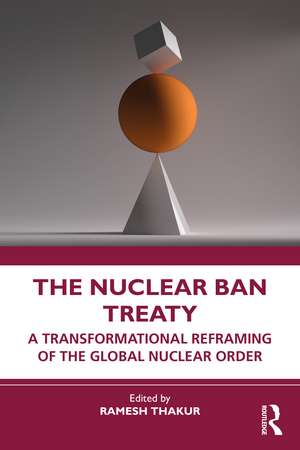The Nuclear Ban Treaty: A Transformational Reframing of the Global Nuclear Order
Editat de Ramesh Thakuren Limba Engleză Paperback – 21 dec 2021
Adopted by the United Nations on 7 July 2017, the Ban Treaty came into effect on 22 January 2021. For advocates and supporters, weapons that were always immoral are now also illegal. To critics, it represents a profound threat to the stability of the existing global nuclear order with the Nuclear Non-proliferation Treaty as the normative anchor. As the most significant leap in nuclear disarmament in fifty years and a rare case study of successful state-civil society partnership in multilateral diplomacy, the Ban Treaty challenges the established order. The book’s contributors are leading experts on the Ban Treaty, including senior scholars, policymakers and civil society activists.
A vital guide to the Ban Treaty for students of nuclear disarmament, arms control and diplomacy as well as for policymakers in those fields.
| Toate formatele și edițiile | Preț | Express |
|---|---|---|
| Paperback (1) | 354.17 lei 43-57 zile | |
| Taylor & Francis – 21 dec 2021 | 354.17 lei 43-57 zile | |
| Hardback (1) | 1004.41 lei 43-57 zile | |
| Taylor & Francis – 21 dec 2021 | 1004.41 lei 43-57 zile |
Preț: 354.17 lei
Nou
Puncte Express: 531
Preț estimativ în valută:
67.79€ • 73.66$ • 56.98£
67.79€ • 73.66$ • 56.98£
Carte tipărită la comandă
Livrare economică 21 aprilie-05 mai
Preluare comenzi: 021 569.72.76
Specificații
ISBN-13: 9781032130705
ISBN-10: 1032130709
Pagini: 272
Ilustrații: 2 Line drawings, black and white; 2 Halftones, black and white; 2 Tables, black and white; 4 Illustrations, black and white
Dimensiuni: 156 x 234 x 15 mm
Greutate: 0.4 kg
Ediția:1
Editura: Taylor & Francis
Colecția Routledge
Locul publicării:Oxford, United Kingdom
ISBN-10: 1032130709
Pagini: 272
Ilustrații: 2 Line drawings, black and white; 2 Halftones, black and white; 2 Tables, black and white; 4 Illustrations, black and white
Dimensiuni: 156 x 234 x 15 mm
Greutate: 0.4 kg
Ediția:1
Editura: Taylor & Francis
Colecția Routledge
Locul publicării:Oxford, United Kingdom
Public țintă
Postgraduate, Undergraduate Advanced, and Undergraduate CoreCuprins
Introduction. Completing the nuclear disarmament agenda: From the NPT to the Ban Treaty PART I: ORIGINS, NATURE, IMPACT 1. The Humanitarian Initiative and the TPNW 2. Cooperation or conflict? Walking the tightrope of NPT and Ban Treaty supporters 3. Towards a nuclear restraint regime: From a normative Ban Treaty to a substantive agenda 4. Does the TPNW contradict or undermine the NPT? 5. Harmonising the NPT and Ban Treaty in nuclear risk reduction measures 6. How many intensive care beds will a nuclear weapon explosion require? 7. On creating the TPNW verification system 8. Nuclear prohibition: The long night’s journey into day 9. The power of a ban: Outlawing nuclear weapons practices 10. Sovereignty as responsibility and the Ban Treaty PART II: COUNTRY PERSPECTIVES 11. Unhinged leaders and nuclear weapons: It’s time to act 12. The TPNW: Russia’s perspectives 13. NATO allies don’t dismiss the TPNW 14. Disarming the unarmed: Current reality of the nuclear Ban Treaty 15. How nuclear-dependent states could respond to the entry into force of the Ban Treaty 16. Folding the Umbrella: Nuclear allies, the NPT and the Ban Treaty 17. The Nuclear umbrella revisited 18. The Nuclear Ban Treaty is a fact 19. Banning nuclear weapons: A role for Germany, the Netherlands and Belgium? 20. In subtle diplomatic move, Canada ceases its opposition to Nuclear Weapons Prohibition Treaty 21. Latin America and quest for nuclear abolition: From the Treaty of Tlatelolco to the Ban Treaty 22. Engaging the nuclear-armed states in the TPNW disarmament process 23. Don’t mention the ban: Australia’s evasion of the TPNW Part III – ARMS CONTROL, DISARMAMENT AND WORLD ORDER 24. Setting new priorities: The EU shifts from civil peace and development projects to military policies 25. Advancing the TPNW 26. Will nuclear states accept post-use responsibility? If not, why not? 27. Mobilising the world behind the nuclear weapons Ban Treaty 28. Verifying the elimination of nuclear weapons and providing assurance against breakout 29. Exploring new approaches to arms control in the 21st century: Lessons from the INF Treaty and Presidential Nuclear Initiatives 30. World order and arms control 31. The future of nuclear arms control: Time for an update 32. Arms control and world order Conclusion. The NPT and the Ban Treaty: Nonproliferation, prohibition, disarmament
Notă biografică
Ramesh Thakur is Emeritus Professor in the Crawford School of Public Policy, The Australian National University; Senior Research Fellow, Toda Peace Institute; and a Fellow of the Australian Institute of International Affairs. His last post was Director of the Centre for Nuclear Non-Proliferation and Disarmament at the ANU. He was formerly Senior Vice Rector of the United Nations University (and Assistant Secretary-General of the United Nations). Educated in India and Canada, he has held fulltime academic appointments in Fiji, New Zealand, Canada, and Australia and been a consultant to the Australian, New Zealand and Norwegian governments on arms control, disarmament and international security issues. He was a Commissioner and one of the principal authors of The Responsibility to Protect and Principal Writer of Secretary-General Kofi Annan’s second reform report; and Co-Convenor of the Asia–Pacific Leadership Network for Nuclear Non-Proliferation and Disarmament. His books include Nuclear Weapons: The State of Play 2015 (CNND); Nuclear Weapons and International Security: Selected Essays (Routledge); andThe United Nations, Peace and Security: From Collective Security to the Responsibility to Protect, 2nd Ed. (Cambridge University Press).
Descriere
The contributors to this book describe, discuss, and evaluate the normative reframing Treaty on the Prohibition of Nuclear Weapons (the Ban Treaty) brings about, taking you on a journey through its genesis and negotiation history and the shape of the emerging global nuclear order.
